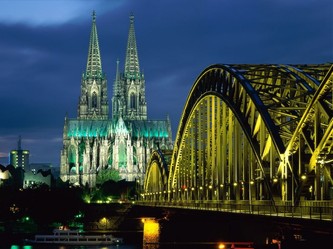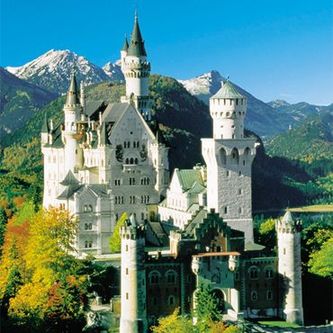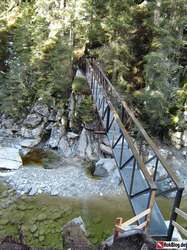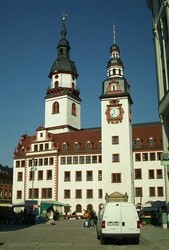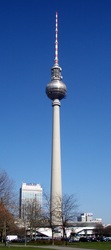Famous Landmarks
Germany has many historical landmarks. Some of these include Brandenburg Gate, Cologne Cathedral, Holsten Gate, Schloss Neuschwanstein, Fernsehturm, Hermannsdenkmal, Frauenkirche, Sanssouci, Zwinger, Altes Rathaus, Rathaus (and Roland statue), Naumburg Cathedral, Untere Bruecke, Kaiserburg, Roemer, Checkpoint Charlie, Berlin Wall Remnants, The Lorelei, Festung Koenigstein, and Museumsinsel.
To me, the most intriguing ones are “The Lorelei” and The Berlin Wall Remnants.
The Lorelei is situated in St. Goarshausen, Germany near the Rhine River, on the eastern river bank. It is about 120 meters above the water line.
Lorelei is also the name of one of the beautiful Rhine Maidens who, legend has it, lured navigators of this river to their dooms with their alluring singing, much like the Sirens of ancient Greek myth. In remembrance of these famous legends, this landmark was opened to tourists. However, since it is a natural landmark it has been there for decades and was even known in the middle ages. The Lorelei itself is made out of schist rock.
It can easily be identified by its 433-foot-high slate cliff near the town of St. Goarshausen, it’s situated in the section known as the Rhine Gorge, directly across the river from Sankt Goar, and lies approximately 30 km south of Koblenz, and it has a Lorelei statue. Ever since it was opened as a tourist attraction, no major renovations have been made. In three simple words, the Lorelei would be described as picturesque, natural, capturing (history/legends).
Today, the Wall remnants can be found in Berlin, Germany. The wall wasn’t dismantled completely as there are two major attractions the Mauerpark and the East Side Gallery. The East Side Gallery runs 1.3 km along the Spree River.
The major significance of this historical landmark is that it symbolized the end of communism in Germany and was the beginning of an “anti-communistic” world.
The actual wall was first built in 1961 and fell in 1989. It was a separation between eastern and western Germany. It was created by the German party GDR (German Democratic Republic).
The Berlin Wall was made of concrete thus the remains are made up of the same material. Although it is under protection order as an historical landmark, the East Side Gallery has fallen victim to the ubiquitous graffiti that permeates Berlin. Sections of the gallery were restored in 2000 to reverse the effects of vandalism and aging. Sadly, even these restored sections have again fallen victim to the spray can.
Approximately 106 paintings by artists from all over the world cover this memorial for freedom and make it the largest open air gallery in the world. It is also covered in graffiti.
Concluding, the Remnants of the Berlin Wall can best be described as artistic, liberating and educative.
To me, the most intriguing ones are “The Lorelei” and The Berlin Wall Remnants.
The Lorelei is situated in St. Goarshausen, Germany near the Rhine River, on the eastern river bank. It is about 120 meters above the water line.
Lorelei is also the name of one of the beautiful Rhine Maidens who, legend has it, lured navigators of this river to their dooms with their alluring singing, much like the Sirens of ancient Greek myth. In remembrance of these famous legends, this landmark was opened to tourists. However, since it is a natural landmark it has been there for decades and was even known in the middle ages. The Lorelei itself is made out of schist rock.
It can easily be identified by its 433-foot-high slate cliff near the town of St. Goarshausen, it’s situated in the section known as the Rhine Gorge, directly across the river from Sankt Goar, and lies approximately 30 km south of Koblenz, and it has a Lorelei statue. Ever since it was opened as a tourist attraction, no major renovations have been made. In three simple words, the Lorelei would be described as picturesque, natural, capturing (history/legends).
Today, the Wall remnants can be found in Berlin, Germany. The wall wasn’t dismantled completely as there are two major attractions the Mauerpark and the East Side Gallery. The East Side Gallery runs 1.3 km along the Spree River.
The major significance of this historical landmark is that it symbolized the end of communism in Germany and was the beginning of an “anti-communistic” world.
The actual wall was first built in 1961 and fell in 1989. It was a separation between eastern and western Germany. It was created by the German party GDR (German Democratic Republic).
The Berlin Wall was made of concrete thus the remains are made up of the same material. Although it is under protection order as an historical landmark, the East Side Gallery has fallen victim to the ubiquitous graffiti that permeates Berlin. Sections of the gallery were restored in 2000 to reverse the effects of vandalism and aging. Sadly, even these restored sections have again fallen victim to the spray can.
Approximately 106 paintings by artists from all over the world cover this memorial for freedom and make it the largest open air gallery in the world. It is also covered in graffiti.
Concluding, the Remnants of the Berlin Wall can best be described as artistic, liberating and educative.
